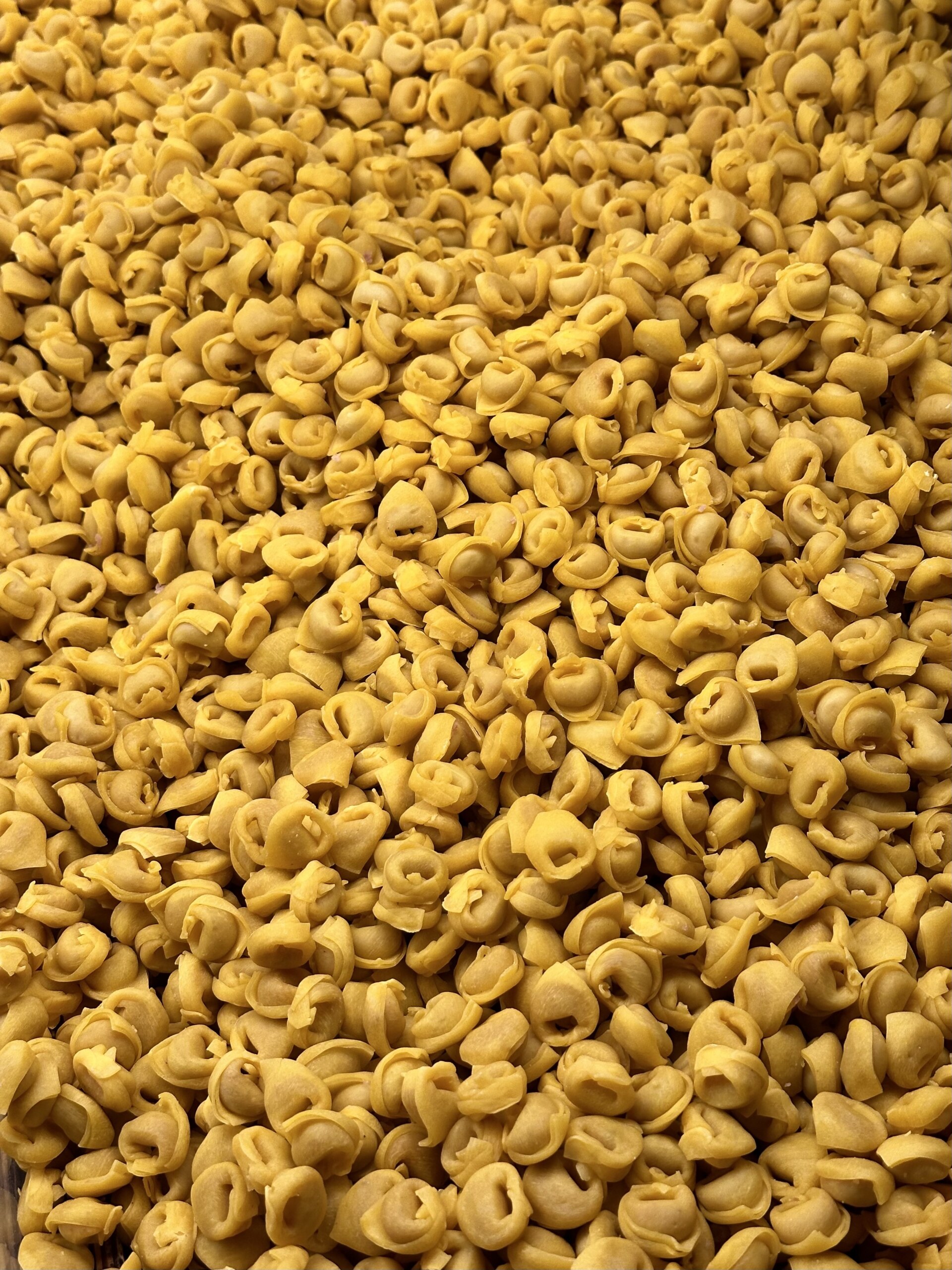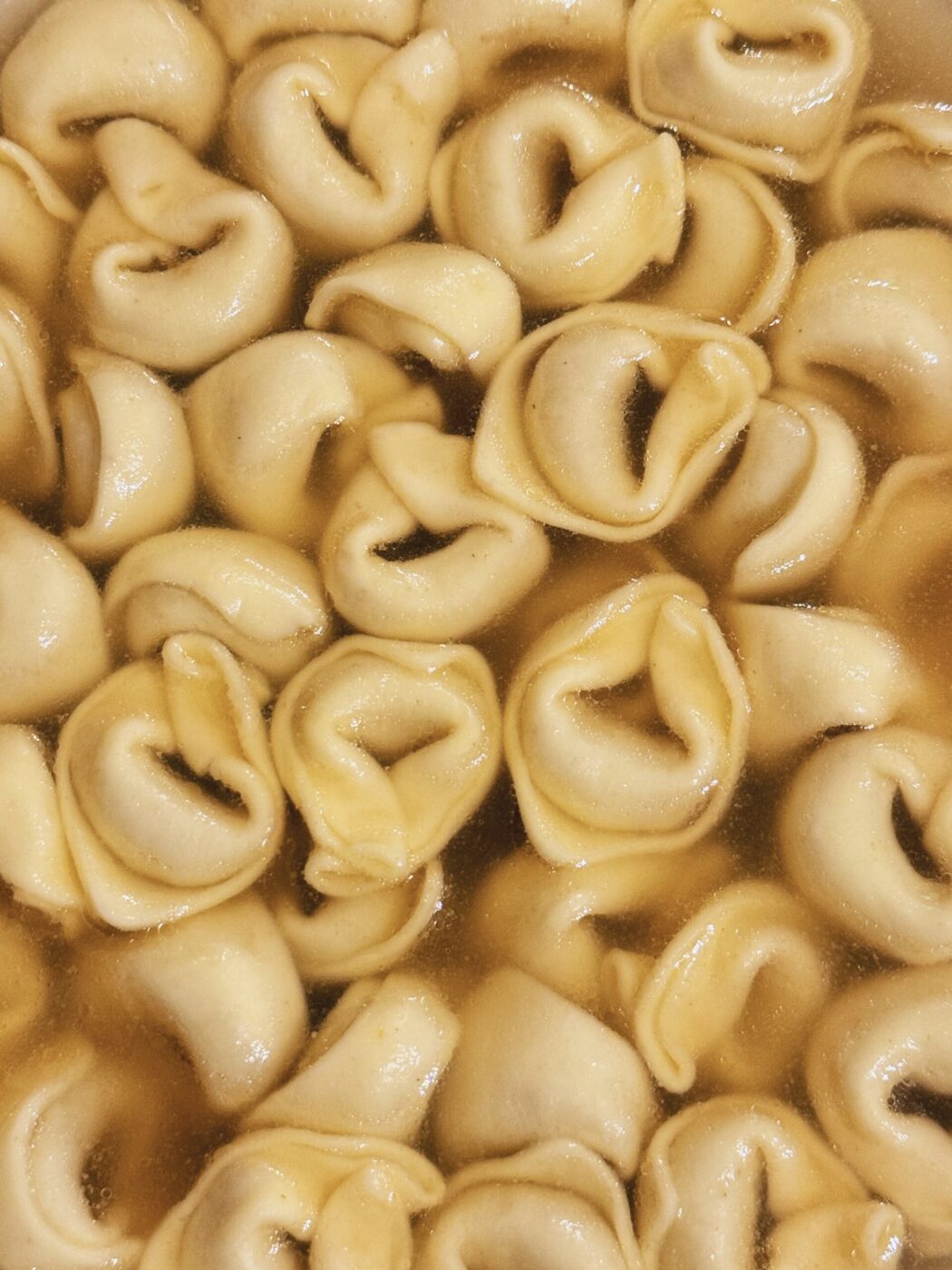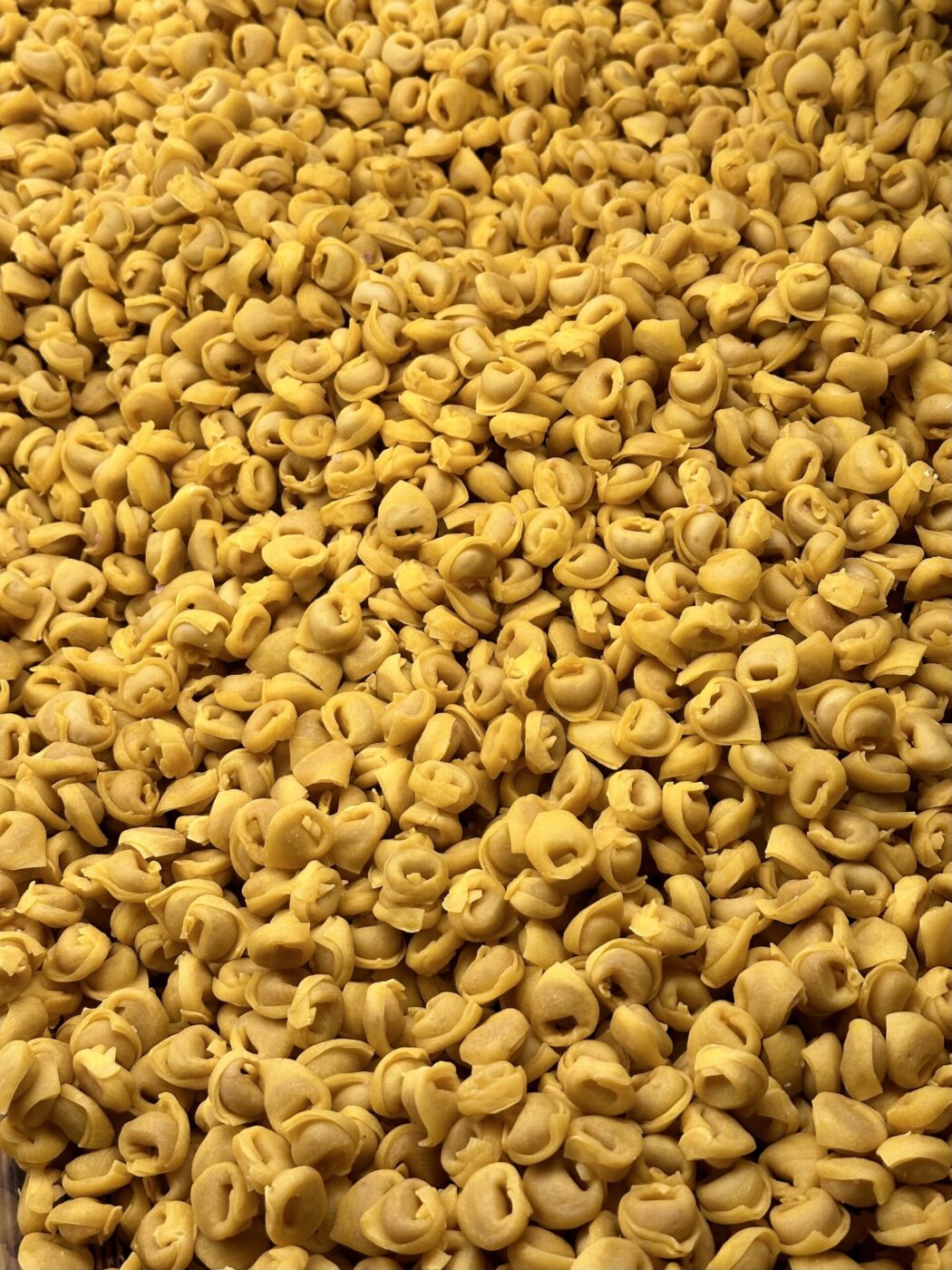Nothing fights the dreaded cambio di stagione like tortellini in brodo. The tiniest of the tortelloni family, Emilia-Romagna’s stuffed pasta icons date back to the Middle Ages, and local lore says their curved button shape resembles the navel of Venus, the goddess of love–it’s no coincidence, perhaps, that National Tortellini Day is celebrated the day before Saint Valentine’s Day. But the dish is more associated with Christmas than the day of love, and you’re sure to find tortellini in brodo on tables nationwide come December 25th.
The Dotta Confraternita Del Tortellino, “Learned Order of the Tortellino”, was founded in 1965 to preserve the dish in its most “authentic” form: tortellini in brodo. Though you’ll often find menus with tortellini served in ragù or in a thick crema Parmigiana, Emilia-Romagnan purists believe the only way to truly appreciate tortellini is by eating them in broth, earning the pasta the nickname re delle minestre, or king of soups. Strict regulations indicate the exact size and weight that the tortellini should be (a max of 2g, according to Chef Alberto Bettini of Trattoria Amerigo), but the quickest way to test if your tortellini is legit is to see if seven unboiled tortellini fit on one tablespoon. When it comes to the recipe, “Every family, every restaurant, believes they have the best,” shares Chef Albero. “But that’s not true. Even if you’re very good, you can at most come in second; the ‘best dish of tortellini’ is always the one that exists in our memory.” For a local Emilia-Romagnan, odds are it’s their nonna’s.
However, here are some guidelines on a super (second-place) tortellini in brodo, courtesy of Alberto and owners of Trattoria del Borgo, Paolo and Sandra.
- The dough: The pasta must be handmade using just “00” white flour and eggs–not water. It should be rolled out with a wooden rolling pin.
- The filling: Inside, the filling should be prosciutto di parma, Parmigiano Reggiano aged for at least 48 months, mortadella, lean pork, eggs, and nutmeg. Paolo says that the meat should be raw, but other tortellini enthusiasts argue it should be cooked first. Alberto insists that the filling-to-pasta ratio should be 1:1.
- The cook: The tortellini should be boiled for only three minutes to make sure the pasta is perfectly al dente.
- The broth: The broth in question is usually di cappone, or made with capon: a rooster that is castrated and fed a rich diet of milk and porridge, resulting in less gamey, more tender, and extra buttery meat. Chicken or beef broth are also acceptable options.
- The serving: Per person, the perfect proportions should be 100g of tortellini and 250ml of broth; at the table, don’t add Parmigiano-Reggiano, the right amount should already be in the filling, adds Alberto.
The marriage of a perfect broth and perfect tortellini isn’t as easy to come by as you may think, and if you know anything about us as an editorial team, we don’t settle when it comes to food. So, read on for our nine favorite places to get tortellini in brodo (and panna!) in and around Bologna.
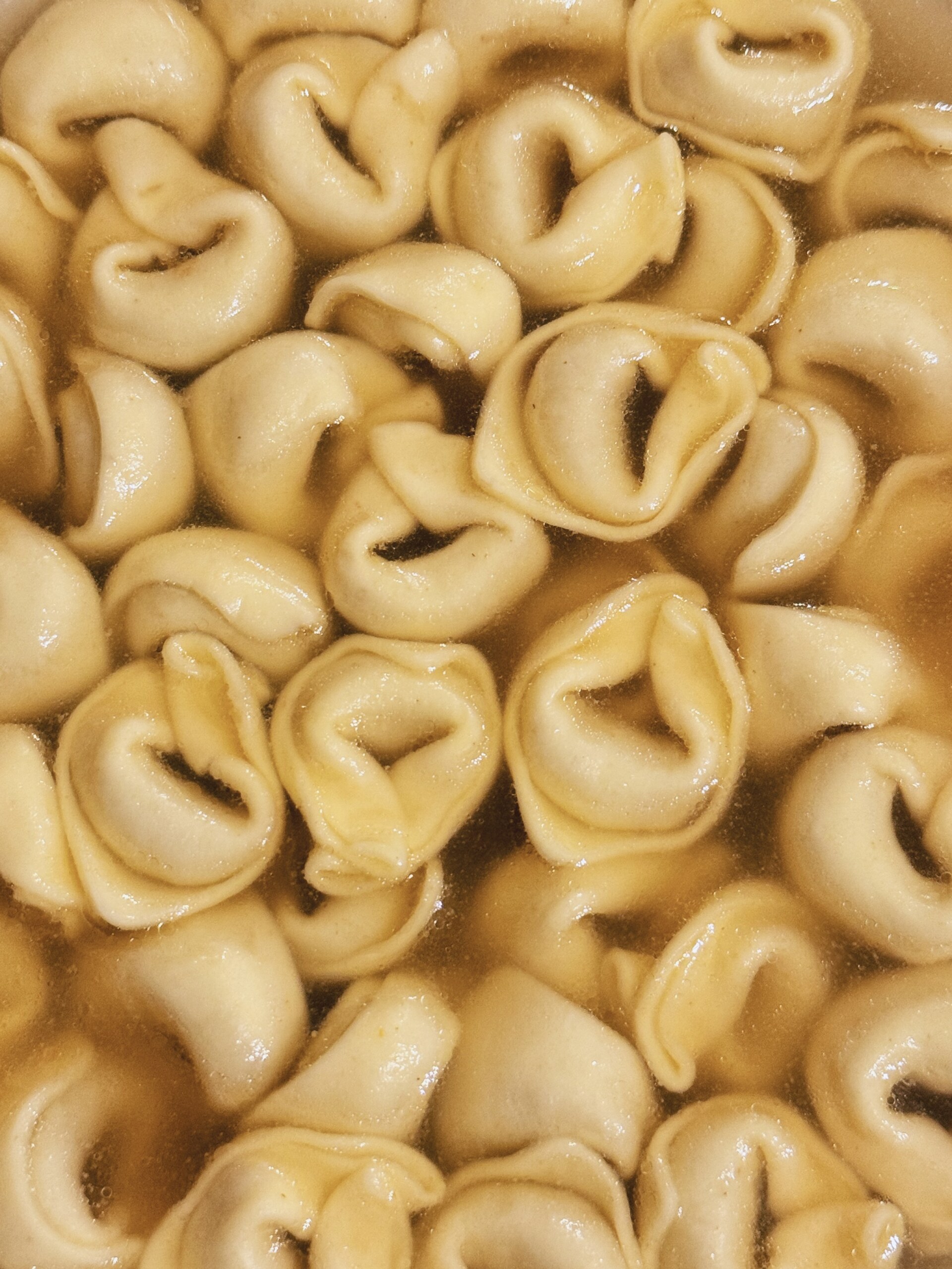
WHERE TO EAT TORTELLINI IN BRODO IN BOLOGNA’S CITY CENTER (MORE OR LESS)
Trattoria di via Serra – One of the few places in Bologna to earn the Slow Food award, this 35-seat trattoria is in Bolognina, the city’s traditionally working-class neighborhood that’s now a hotbed of nonconformity. Owners Flavius–front of house–and Tomasso–head chef–make the best brodo di cappone in Bologna, filled to the brim with their light, soft, and fragrant tortellini. Here, they emphasize local ingredients, partnering with high-quality Emilia-Romagnan producers such as Caseificio Rosola di Zocca for cheese, the Azienda Agricola Mesini for organic flour, Forno Brisa for bread, and Macellaio Ezio for meat. Other standout dishes include the ricotta-stuffed tortelloni tossed in butter and sage and the cordonetti verdi pasta with porcini and galletti.
All’Osteria Bottega – Tucked under a portico on the edge of the city, this restaurant, which also boasts a Slow Food stamp, is slightly more upscale than a typical trattoria, but that doesn’t mean the perfectly executed classics aren’t simple and hearty. All the ingredients and wines are top-notch, the latter coming via recommendation of the waiters rather than on a physical wine list. Their tortellini in brodo di cappone is just the way we love it: with more tortellini than broth, cheekily labeled “Ricordo il profumo del brodo di cappone della ‘domenica’ e i tortellini” (“I remember the smell of the capon broth on Sunday and the tortellini”) on the menu. Equally delicious are the little tortellini doused in crema parmigiana–the dish put in its rightful second place here under “l’altro tortellino…” (“the other tortellino…”).
Trattoria Da Me – Since 1937, this cozy trattoria has been a family affair: it was first opened by two siblings and their respective partners and, today, is run by their grandchildren. The secret to their tortellini (and all their pasta) is that they make the dough fresh, entirely by hand, every day. Stop by their pasta window (Via San Felice 52/A) to pick up said pasta and to watch them roll out the giant yellow (and sometimes green!) sheets. Though their cotoletta alla Bolognese won the trattoria a place on Alessandro Borghese’s Quattro Ristoranti TV show, it’s really the soft, bright tortellini, filled with parmesan and prosciutto and packed into a steaming bowl of brodo, that we fantasize about here.

Tortellini in Brodo, Trattoria Da Me, Bologna
WHERE TO EAT TORTELLINI IN BRODO OUTSIDE BOLOGNA’S CITY CENTER
Trattoria Amerigo – Open since 1934, this trattoria led by Chef Giacomo Orlandi is probably one of the best Michelin starred restaurants in Italy–though you might not even realize it for the laid back vibe. The menu features the year each dish made it on, and after ordering, you’ll realize why they’ve been staples for so long, especially when paired with one of their local wines from the surrounding Colli Bolgonesi. The star once again, is their tortellini, served in an uber-flavorful brodo di gallina vecchia, chosen because these “old hens” are available from local farms year round, whereas local capons are only available a few weeks in the winter. “Our idea is this,” shares head Chef Alberto Bettini, “only high-quality, local ingredients for the filling, for the dough, and for the broth. Everyone says this, but no one actually does it.”
Antica Osteria del Mirasole – In the Bassa Bolognese area just 20 minutes off the A1, you’ll spot this trattoria first by its bright, sunflower-colored facade. Inside, the tavern-style spot is warm and inviting, partially from the cute, mid-20th century design and partially thanks to the owner and head Chef Franco Cimini, who can be found grilling delicious-smelling meats over a stone fireplace. Their fabulous tortellini goes a bit against the current and comes swimming in the “broth” of our dreams–not a typical brodo, but one of cream–though we understand how sacrilegious this may be to Bolognese, not to mention the Confraternita. But it’s not just any panna–they make theirs at their own family-run caseificio, Sant’Angelo, by using the cream that rises (“affioramento“) to the top of their vats of Parmigiano Reggiano. In regards to the tortellini themselves, Chef Franco writes in the osteria’s eponymously titled book, “Although I started from the Bolognese recipe that calls for broth, I followed my instincts… I have studied for years the balance of these ingredients, from the filling to the seasoning, only to discover that the determining ingredient is the pork loin.”
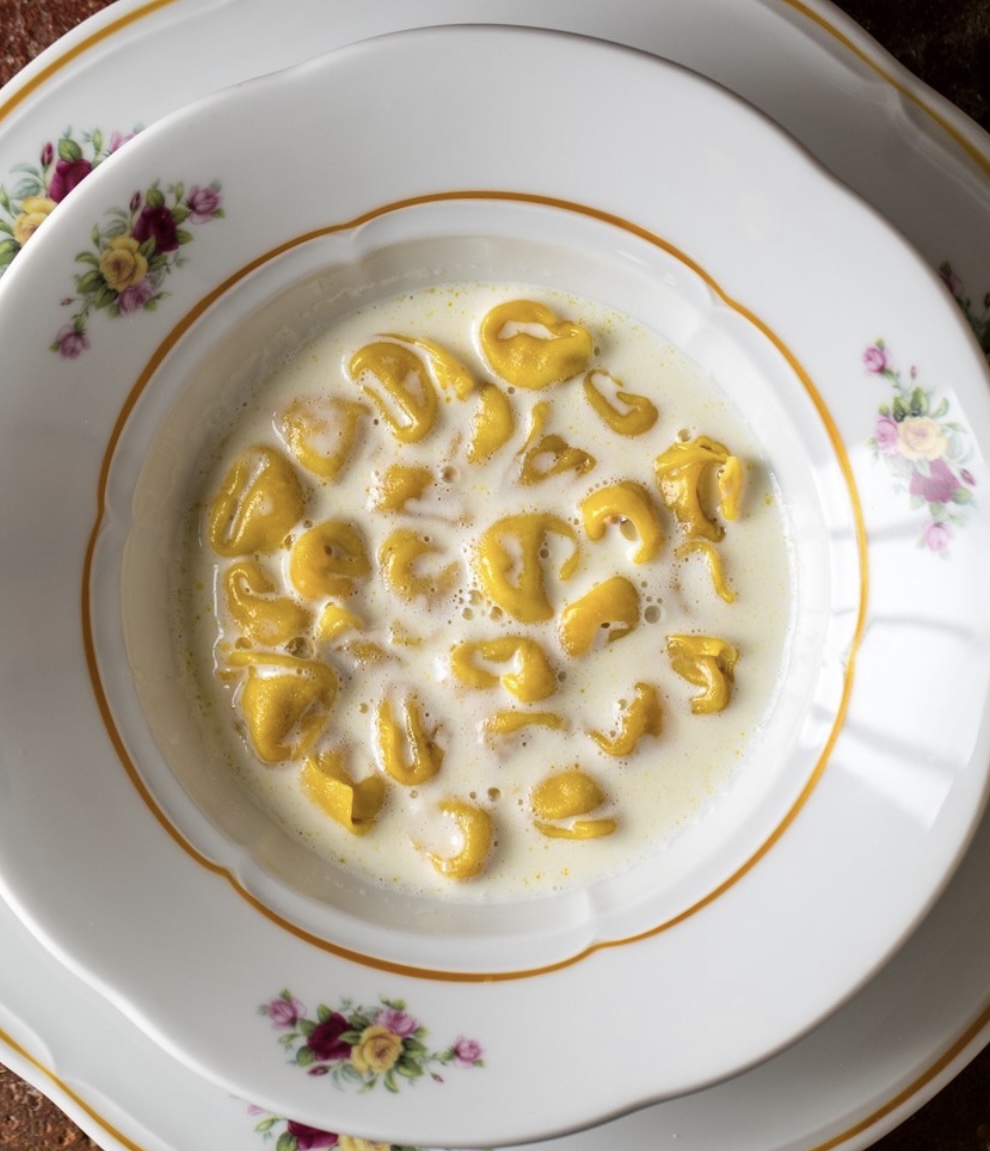
Tortellini Alla Panna D'affioramento at Osteria Mirasole
Ristorante Massimiliano Poggi – Chef Massimiliano Poggi’s eponymous restaurant has the menu and service of a fine dining establishment, but the vibe of a traditional, cozy country house. Here, two pre-fix menus follow Chef Massimilano’s culinary philosophies of seasonality and using local products, with dishes like artichoke cappelletti in a scampi broth or “risotto of the Po’ River Delta” with parmesan whey and seasonal herbs. You can also order a la carte (the crescentine is a must), which is our preferred method since it means we can devour a bowl of their tortellini in doppio brodo di cappone, in a broth so rich it almost could be cream. It’s well-worth the trek to Trebbo di Reno Bologna and the higher price tag.
La Lumira – Run for over half a century by the Borsarini family, La Lumira is currently under the expert hand of Chef Carlo Alberto Borsarini, who constantly makes innovative, creative versions of the typical Emilia-Romagnan lineup. “Tortellino is a hidden treasure; you can’t see what it contains, but you must trust your taste,” shares Chef Carlo. “The prosciutto, mortadella, pork, and Parmigiano Reggiano must be the best you can find.” This makes their tortellini in brodo di cappone out of this world. So does the restaurant’s location in the town of Castelfranco Emilia, where the annual sagra of tortellini in brodo is. There’s been a long, long rivalry between Bologna and Modena over the proper way to prepare tortellini, and though the town of Castelfranco was once part of Bologna’s territory and now belongs to Modena, Chef Carlo just sees this as an excuse to combine the culinary traditions of both sides of the region.
Antica Trattoria Della Gigina – With blue awnings hanging over the doorway, this no-frills trattoria right outside Bologna in Corticella is THE pranzo della domenica hotspot, though it’s filled with locals every day of the week. Pasta is still made here with as much passion as when the place was founded in 1956 by Aldina Fava (later known as Gigina)–and it’s made twice a day, so you really can’t find any fresher tortellini. When you order the tortellini in brodo, the (always kind) waiters bring it in a large ceramic cauldron that they dish out tableside. Pair it with a bottle or two from their over 300 label collection–and pour a bit of red in your brodo like the Romagnan nonni do.
Trattoria del Borgo – Head to the incredibly adorable small town of Monteveglio in Colli Bolognesi for this real local gem. The rustic, old stone building with a large front terrace is about as charming as owners Paolo and Sandra, who are passionate with a capital P about making dishes according to tradition of the region. During the winter, it’s perfect to cozy up by their fireplace with a simple bowl of tortellini in brodo–made, of course, according to the guidelines above–though we would gladly come to eat theirs all year round.
